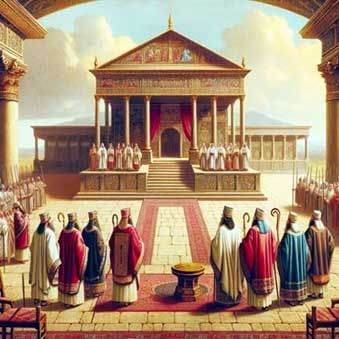LESSON 5: Aaron and the Tabernacle
Lesson 5: Aaron and the Tabernacle
Aaron was the older brother of Moses and played a crucial role in the events of the Exodus. When God called Moses to lead the Israelites out of slavery in Egypt, Aaron became his spokesperson, helping to communicate God’s message to Pharaoh and assisting in performing miracles. Later, after the Israelites escaped Egypt, Aaron was appointed as the first high priest by God. His role as high priest was significant because it meant he was responsible for performing the rituals and sacrifices.
Today we have a certain place for worship and that is the church. But in ancient times there was no particular place or time for worship. Since the Israelites were traveling most of the time, they had to think of a portable tabernacle. It was designed to be a place where God could dwell among his people, and it served as the center of Israel’s worship and sacrifice until the construction of the permanent Temple in Jerusalem. The Tabernacle was constructed with materials that were highly symbolic, including gold, silver, bronze, fine linen, and precious stones. The Israelites generously contributed materials for its construction, demonstrating their devotion to God’s command.
The Tabernacle was constructed with a frame made of acacia wood, overlaid with gold, and covered with curtains of fine linen and animal skins. All the men took part in the making of the Tabernacle.
The Tabernacle was divided into three main areas: the Outer Court, the Holy Place, and the Holy of Holies. The outer court, called Thirunivasam, housed the altar for burnt offerings and a basin for ceremonial washing. The bronze basin was positioned between the altar and the Tabernacle; it was used by the priests to wash their hands and feet before entering the holy areas, symbolizing purification before approaching God (Exodus 30:18-21). This was covered with a curtain with cherubim (angels) worked into it. The south, north, and western sides were covered by acacia wood overlaid with gold sheets. The door and the curtain were on the east side. The curtain was woven with fine yarn and beautiful embroidery.
The Holy Place was the first inner chamber of the Tabernacle. Only the priests could enter this area to perform their duties. The Holy Place contained the altar of incense, the table for the Bread of the Presence, and the golden lampstand.
The Holy of Holies was the innermost and most sacred part of the Tabernacle. The curtain separated the Holy Place from the most holy place. It housed the Ark of the Covenant containing the Ten Commandments, and it was the place where God’s presence dwelled in a special way. Outside of the Tabernacle, around it, there was a big place covered with curtains called the prakaram. The curtain in front of the prakaram was drawn to one side so that the people could see the inside.
Aaron was appointed by God as the first High Priest (Exodus 28:1). This role involved overseeing the spiritual practices of the people, offering sacrifices, and serving as a mediator between God and the Israelites. His descendants would continue this priestly role throughout history. Aaron and his sons were given special garments to wear while serving in the Tabernacle (Exodus 28). These garments were symbolic, signifying their holiness and dedication to God. The garments included a tunic, a breastplate with 12 stones representing the tribes of Israel, and a turban with a gold plate inscribed with “Holy to the Lord.”
What can we learn from Aaron and the Tabernacle?
From Aaron and the Tabernacle, we learn valuable lessons about worship, obedience, and God’s holiness. Aaron’s role as High Priest teaches us the importance of reverence and following God’s instructions precisely, highlighting that our relationship with God requires obedience. The Tabernacle’s design and the rituals performed there remind us of the need for holiness in our lives, as everything in the Tabernacle pointed to God’s sacred presence. Additionally, Aaron’s role as a mediator shows the significance of interceding for others through prayer, while the sacrifices emphasize the need for atonement and forgiveness. Ultimately, the story encourages us to live with humility, reverence, and a heart devoted to God’s service.
Questions:
- Which are the three main areas of the Tabernacle?
- What is the Tabernacle?
- What was the position given to Aaron and his sons?
- What significance did the garments worn by Aaron and his sons have in their priestly duties?
- Where was the Ark of the Covenant kept?
- What was kept inside the Ark?

